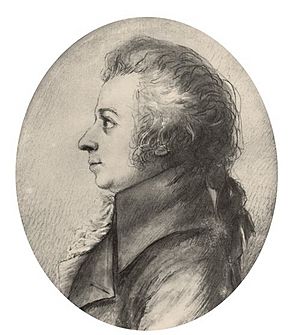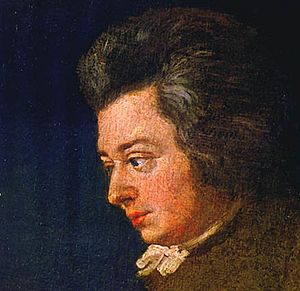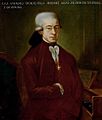Wolfgang Amadeus Mozart facts for kids
Quick facts for kids
Wolfgang Amadeus Mozart
|
|
|---|---|

Silverpoint drawing by Doris Stock, 1789
|
|
| Born |
Johannes Chrysostomus Wolfgangus Theophilus Mozart
27 January 1756 |
| Died | 5 December 1791 (aged 35) |
| Cause of death | Uncertain |
| Resting place | Vienna |
| Nationality | Austrian |
| Occupation | Composer, instrumentalist, music teacher |
| Years active | 1761 – 1791 |
|
Notable work
|
The Marriage of Figaro Don Giovanni Cosi fan tutte The Magic Flute Symphony in C major ("Jupiter") Piano Concerto in D minor Clarinet Concerto in A major Serenade for 13 Wind Instruments Requiem |
| Style | Classical |
| Spouse(s) | Constanze Weber |
| Children | 6 children. 4 sons and 2 daughters. |
| Parent(s) | Leopold and Anna Maria Mozart |
| Relatives | Marianna (sister) |
| Signature | |
Wolfgang Amadeus Mozart (born January 27, 1756 – died December 5, 1791) was an amazing Austrian composer. A composer is someone who writes music. He was also a talented musician and music teacher. His full name was Johannes Chrysostomus Wolfgangus Theophillus Mozart.
Wolfgang was born in Salzburg, Austria, the youngest child of Leopold and Anna Maria Mozart. From a very young age, he showed incredible musical talent. He traveled all over Europe with his parents and older sister, "Nannerl." They performed for kings, queens, and other important people.
As a young man, Mozart tried to become a famous composer in Paris. When that didn't work out, he returned to Salzburg. He felt that Salzburg was too small for his huge talent. So, he moved to Vienna, where he found more success. He married Constanze Weber and they had two sons. Mozart died in Vienna after a short illness.
Mozart wrote over 600 musical pieces. All of them are considered very high quality. His famous works include the operas The Marriage of Figaro, Don Giovanni, Così fan tutte, and The Magic Flute. He also wrote many symphonies, like the "Jupiter" symphony. He created concertos for piano, violin, and other instruments. Along with Bach and Beethoven, Mozart is known as one of the greatest composers ever.
Contents
Mozart's Early Life
His Family and First Years
Wolfgang Amadeus Mozart was born in Salzburg, Austria. His parents were Leopold and Anna Maria Mozart. Leopold was a violinist in the archbishop's orchestra. He also wrote a popular book about playing the violin.
Young Wolfgang, often called "Wolfi," showed great musical skill very early. He was playing the harpsichord and violin by age five. He was even writing his own small pieces of music.
Wolfgang's sister, Marianna, called "Nannerl," was also a talented musician. Their father taught both children music and other school subjects. The family then traveled around Europe for several years. They performed for royal families and wealthy people.
Traveling and Learning
Mozart performed in many cities, including Munich, Prague, Paris, The Hague, and London. In London, he played for King George III. He also met composer Johann Christian Bach, one of Johann Sebastian Bach's sons. Wolfgang, at just eight years old, even improvised a fugue while sitting on Bach's knee. He also heard his first two symphonies performed there.
Eventually, the Mozart family returned to Salzburg. But in 1768, they went to Vienna again. There, twelve-year-old Wolfgang put on his first opera, Bastien und Bastienne. Around this time, he got smallpox. He recovered, but the illness left marks on his face.
He then traveled to Italy. There, he heard music by many famous Italian composers. One story tells how he heard a special piece called Miserere by Gregorio Allegri. This music was only for the Pope's Vatican choir. No one was allowed to have the written music. But Mozart heard it once and wrote it all down from memory! He met the Pope and was given a special award, a knighthood.
In 1777, Mozart traveled with his mother. In Mannheim, he met and fell in love with Aloysia Weber. She was 16 and studying singing. Mozart wanted to take her to Italy to make her famous. However, his father stopped these plans. By 1778, Mozart and his mother were in Paris. Sadly, his mother died there.
Life in Vienna
New Beginnings
Mozart wrote some small operas when he was young. But his first truly important opera was Idomeneo. It was first performed in Munich in 1780. The next year, he went to Vienna. At this time, he worked for the Archbishop of Salzburg, just like his father.
When he went back to Salzburg, he argued with the Archbishop. The Archbishop actually fired him! So, Mozart moved to Vienna, where he would live for the rest of his life.
In 1782, he married Constanze Weber. She was one of Aloysia's younger sisters. Mozart and Constanze had seven children, but five of them died when they were very young. Mozart’s father did not approve of the marriage. Constanze was a loving wife. However, like Mozart, she was not good with money. This meant they were often quite poor.
In that same year, 1782, Mozart wrote another very successful opera. It was called Die Entführung aus dem Serail ("The Abduction from the Seraglio"). A famous story says that after the emperor heard the opera, he told Mozart there were “too many notes.” Mozart replied, “Just as many as are necessary, Your Majesty.”
Friendships and Fame
Mozart began a series of concerts where he played his own piano concertos. He would also lead the orchestra from the piano. He met the famous composer Joseph Haydn. The two men became great friends. They often played together in a string quartet. Haydn once told Leopold Mozart: "Before God and as an honest man I tell you that your son is the greatest composer known to me. He has taste, and what is more, the most profound knowledge of composition." Mozart and Haydn were both part of the same Masonic Lodge. Mozart even dedicated some of his string quartets to Haydn.
After a few years, audiences in Vienna didn't support Mozart as much. So, he often went to Prague, where people loved his music. His opera The Marriage of Figaro was very popular there. In 1787, he performed his opera Don Giovanni for the first time in Prague.
Mozart's Final Years
Last Works and Death
There are different stories about Mozart’s last illness and death. It is hard to know exactly what happened. He was working on an opera called The Magic Flute. This is one of his best and most popular operas today. It is written in German, not Italian, like most of his other operas. It is a bit like a fun play with music.
While working on The Magic Flute, a stranger asked him to write a requiem. A requiem is a special mass for the dead. He was told to keep this work a secret. Then, he was asked to write an Italian opera, La Clemenza di Tito. This opera was performed in Prague in September 1791. At the end of September, The Magic Flute had its first performance.
Mozart then worked very hard on the Requiem. He must have known he was very ill. In a way, the requiem was for himself. He died in Vienna before he could finish it. Constanze asked another composer, Franz Xaver Süssmayr, to complete the work. Mozart was buried in the St. Marx Cemetery.
Mozart's Music Style
Mozart's music, like Haydn's, is a perfect example of the Classical style. When he started composing, the Baroque period was ending. Musical tastes were changing. People wanted music that focused on form, balance, and elegance. These things were becoming more important than counterpoint (where different melodies play at the same time).
Mozart was the first great composer to write a lot of music for the piano. This instrument was just becoming popular. He wrote almost every kind of music. This included symphonies, operas, solo concertos, and chamber music. He also wrote many string quartets and string quintets, and piano sonatas. He wrote a lot of religious music, like masses. He also wrote popular music, such as dances, divertimenti, and serenades.
When Mozart was young, a symphony was usually a short, simple piece for entertainment. Mozart changed the symphony into a carefully planned piece that could last up to half an hour. His last three symphonies are especially famous masterpieces. His concertos, especially his piano concertos, were much more advanced than anything written before.
Operas and Popular Tunes
Mozart's operas are among his greatest works. He understood people's personalities very well. He could write music that showed everything about the characters in his operas. He wrote three operas with words by Lorenzo Da Ponte. These were Don Giovanni, Le Nozze di Figaro (The Marriage of Figaro), and Cosi fan tutte. Each of these has very clever parts where several characters sing at once. Each singer shows their own feelings about the situation.
Besides his masterpieces, Mozart also wrote many popular pieces. Some of these tunes are still known by everyone today. His serenade Eine kleine Nachtmusik K525 is famous everywhere. So is the Turkish Rondo from his Piano Sonata in A K331. The beginning of the Symphony No. 40 in G minor K550 is also very well-known. And don't forget the birdcatcher’s song from The Magic Flute K620.
Catalogue of Works
After Mozart died, a man named Köchel studied all of Mozart’s music. He tried to put them in chronological order (the order they were written). He gave each piece a number. This number helps us know exactly which work is being talked about. For example, Symphony in G minor K183 is different from Symphony in G minor K550. The "K" stands for Köchel. Sometimes it is written "KV550," which means "Köchel Verzeichnis" (Köchel Catalogue). The highest Köchel number is 626, which is his requiem mass.
Related Pages
Images for kids
-
Portrait of Mozart wearing the Order of the Golden Spur, received in 1770 from Pope Clement XIV in Rome. The painting is a 1777 copy of a work now lost.
-
A facsimile sheet of music from the Dies Irae movement of the Requiem Mass in D minor (K. 626) in Mozart's own handwriting. It is located at the Mozarthaus in Vienna.
See also
 In Spanish: Wolfgang Amadeus Mozart para niños
In Spanish: Wolfgang Amadeus Mozart para niños









